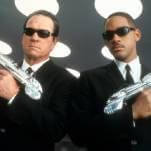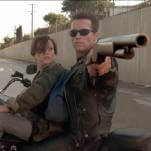Spider-Man 3 swung to the top of a year dominated by lousy third installments
Image: Graphic: Libby McGuire

The three part threes all arrived in May of 2007, one after the other after the other. First weekend in May: Spider-Man 3. Third weekend: Shrek The Third. Fourth: Pirates Of The Caribbean: At World’s End. Each of those part threes earned nearly a billion dollars at the global box office. In North America, Spider-Man 3 was the biggest hit of the year, and Shrek The Third was close behind it. At World’s End came in at #4. Michael Bay’s first Transformers earned about $10 million more, just barely edging Gore Verbinski’s third Pirates adventure off of the podium. Outside North America, At World’s End was 2007’s big winner.
Really, though, all of them were winners. By 2007, studios had learned that they could rely on name-value franchises. If an idea worked once, it would work again. All three of those part threes were fantastically expensive, but all of them were also hugely lucrative. These were big, effects-heavy adventures with movie stars and romantic subplots and comedy scenes, and they were familiar. Those three movies were merely the biggest part threes of the year; theaters were lousy with them in 2007, the year of The Bourne Ultimatum, Ocean’s Thirteen, Rush Hour 3, and Resident Evil: Extinction. The formulas were working. The part threes were winning.
Those part threes were winning even though they were terrible. All three of the big May sequels are case studies in just how hard it is to maintain a franchise. By their third installments, the Spider-Man, Shrek, and Pirates series had lost all sense of charm, storytelling momentum, and scale. The three weren’t created equal in the first place, but at their best, all counted as effective blockbuster filmmaking. Spider-Man 2 (2004), the best film in any of those franchises, is a vivid, inventive, minor masterpiece of a movie—one of the early examples of just how much fun the big-budget superhero sequel could be. It’s not fair to ask every blockbuster to be Spider-Man 2, but it’s fair to ask that these big-product movies accomplish something. The three part threes of May 2007 don’t offer much of anything.
In certain film-nerd corners, 2007 has a reputation for being a great movie year, mostly because of the Oscar-night showdown between There Will Be Blood and No Country For Old Men. You could definitely walk into multiplexes that year and find cool things: Michael Clayton, Zodiac, Superbad, Ratatouille, Knocked Up, The Orphanage, Hot Fuzz, Gone Baby Gone, The Mist, The Assassination Of Jesse James By The Coward Robert Ford. Some of those movies were even hits! But if you look at the biggest movies of 2007, you will find a whole lot of empty and charmless repetition. You will find studios desperate to run their best ideas into the ground.
Spider-Man 3, Shrek The Third, and Pirates Of The Caribbean: At World’s End aren’t necessarily bad in the same ways. At World’s End, for instance, is numbingly long and obsessively devoted to its own incoherent mythology. Shrek The Third drowns in its rancid snark-bile, which was already starting to curdle by the time the credits rolled on the first Shrek six years earlier. Spider-Man 3, meanwhile, is a strange case of an often great filmmaker twisting himself up into pretzels in an attempt to please himself, his audience, and his producers. Those producers, at the very least, must have been happy.
With 14 years of hindsight, the whole Spider-Man 3 narrative seems clear. After the success of his first two Spider-Man films, Sam Raimi had ideas about moving his versions of Peter Parker, Mary Jane Watson, and Harry Osborn into something resembling adulthood. Raimi got excited about the visual possibilities of the Sandman, a classic Spider-Man villain, and he was also thinking about including the Vulture. Raimi worked on a script with his brother Ivan, a Michigan doctor who’d been his writing partner on Darkman and Army Of Darkness, and with the veteran screenwriter Alvin Sargent. (Sargent, who turned 80 a month before Spider-Man 3 hit theaters, had written Spider-Man 2, and he was married to Spider-Man series producer Laura Ziskin. He had been writing movies since the ’60s. He’d won Oscars for 1977’s Julia and 1980’s Ordinary People. Wild career on that guy!)
But Avi Arad was not content with making another Sam Raimi Spider-Man movie. Arad, a former toy executive, had become one of the higher-ups at Marvel during the comic company’s floundering financial years in the ’90s, and he’d been the driving force behind establishing Marvel Studios. By the time Marvel started making its own movies, though, Arad was out. Instead, he produced the movies that other studios made out of licensed Marvel properties. Arad’s track record is mixed. In 2007 alone, he produced Spider-Man 3, Ghost Rider, Fantastic Four: Rise Of The Silver Surfer, and Bratz. I get mad just looking at that list. Arad really wanted Raimi to put Venom in a movie. In the comics, Venom is an incoherent character with an impossibly twisty years-long backstory, but Arad knew that fans liked Venom. He insisted. Raimi caved.
The movie does too much. It’s got origin stories for Venom and Sandman. It’s got Peter Parker getting covered in alien goo that gives him enhanced powers and a slick new look but that also sends him on his journey into becoming a jazz-dancing asshole. It’s got two different intersecting love triangles. It’s got Harry Osborn trying to kill Parker, almost dying, losing his memory, becoming friends with Parker again, then trying to kill Parker again, almost dying again, becoming friends with Parker again, before finally and mercifully dying. The film is two and a half hours long, and it barely ever pauses to catch its breath.
Raimi talked himself into the whole Venom thing by thinking about the blurry line between good and evil—about how good people make mistakes and bad people have redeemable moments. In confronting his own worst tendencies—tendencies magnified by alien goo—Parker learns to interrogate the false binaries in his life and the stories he’s written for himself. That’s the idea, anyway. But with so much plot machinery in action, Raimi is limited to showing his characters screaming their own internal monologues at mirrors in five-second bursts.
There are some interesting ideas and scenes amid all the noise of Spider-Man 3. For two movies, Tobey Maguire had played Peter Parker as a squeaky, sweaty dork. When he starts believing his own hype in Spider-Man 3 (“I don’t know, I guess I’ve become something of an icon”) it works as a convincing argument against the inherent virtue of nerdery. Also, there are a few individual scenes, especially the gothic-expressionist birth of the Sandman, where Raimi reminds the world that he’s essentially a horror director. The sight of Thomas Haden Church dissolving into dust remains unsettlingly effective.
Those ideas only rarely get a chance to make an impression. Spider-Man 3 remains anchored to its busy plot and to perceived expectations for a new Spider-Man movie. Much of the film is on autopilot. It’s the third straight film, for instance, where a too-charming-for-this Kirsten Dunst has to spend a big action scene screaming in terror while precariously suspended from great heights and where onlookers stare up at the super-powered fights happening over their heads, apparently not worried about the inevitable falling debris. In its day, Spider-Man 3 was the most expensive motion picture ever made, and yet it still has the same primitive-CGI issues that affect all the Raimi Spider-Man joints. It has a lot of CGI, but it doesn’t have especially good CGI, so the loud climactic fight really just looks like pixels flying over Midtown.
The Spider-Man 3 casting makes for a fascinating time capsule. Tobey Maguire, Kirsten Dunst, and the wooden James Franco were all holdovers from previous films, but Raimi did well when he cast Bryce Dallas Howard, who’d never been in a big movie, as Peter Parker’s impossibly hot supermodel science-nerd dreamgirl Gwen Stacy. Howard’s Gwen is not a remotely plausible or three-dimensional figure. But then again, neither is anybody else, and Howard at least has charisma. The other big casting choices didn’t go so well. It’s pretty funny to think that Raimi brought in former sitcom star Thomas Haden Church, coming off of an Oscar nomination for playing a charming cad in Sideways, to glower and brood his way through Sandman’s hackneyed arc. (Church’s Sideways costar Paul Giamatti would have to wait another seven years until he got his own Spider-Man villain role, but Giamatti’s face-tatted Russian-gangster version of the Rhino turned out to be the only good thing about The Amazing Spider-Man 2.)
And then there’s Topher Grace. Grace was another former sitcom guy. He was a couple of years out from finishing a long run on That ’70s Show, and he seemed like he’d have a real film career ahead of him. If Grace had been cast in a different superhero movie—if, for instance, he’d had a crack at the fast, smirky patter of a Jon Favreau-style Marvel film—then he might have popped. Instead, he’s forced to play Eddie Brock as a grating, smarmy dickhead before becoming an entirely menace-free version of Venom. (Grace reportedly packed on a whole lot of muscle for the role. You can’t tell.)
At some point while working on Spider-Man 3, Raimi must’ve realized that he couldn’t manage everything. He had a hard deadline; the release date for the third Spider-Man was announced before the second film even came out. Much of Spider-Man 3 feels like the work of a checked-out filmmaker going through the motions. There are also a few moments where it’s pretty clear that Raimi would much rather be making a musical. The infamous jazz-dancing scenes seemed hugely embarrassing at the time, but they’re some of the only parts of Spider-Man 3 that have really aged well. The dancing stuff has a reason to exist. It shows that Peter is such an incorrigible dweeb that he doesn’t realize how goofy his cool-guy moves come off. Raimi conveys that impression without the hackneyed dialogue that dogs the rest of the movie, and he also shows Tobey Maguire gyrating in that doorway for about five beats longer than necessary. That bit of pure silliness is one of the rare moments where Spider-Man 3 crackles to life.
It wouldn’t happen again. After the artistic failures and commercial triumphs of their part threes, the Shrek and Pirates Of The Caribbean movies continued to limp along. The Spider-Man franchise did not. Raimi spent years working on a fourth Spider-Man, but he came to detest the version that was taking shape, and he finally announced that he couldn’t finish the movie in time for its planned 2011 release date. Maguire and Dunst refused to return without Raimi, and Spider-Man was dead in the water. The producers of Spider-Man had essentially hounded their hugely successful franchise out of existence. Rather than a fourth movie, they slapped together Marc Webb’s disastrous Amazing Spider-Man reboots. When those bricked, Sony resorted to leasing the character back to the Marvel people, who had some idea what to do with it.
It’s funny. By 2007, franchises had come to rule Hollywood. That year, six of the 10 highest-grossing movies were sequels, while another two, Transformers and Alvin And The Chipmunks, were kids’-TV adaptations that were clearly intended to spin off sequels (or squeakquels) of their own. But Hollywood had not yet learned how to manage those franchises. At the time, the blueprint was to just keep hammering away repetitively at past successes until everyone was sick of them. But that was changing. A year later, Iron Man came out and hinted at the idea of an interconnected, self-sustaining movie universe. People still complain, with good reason, about how franchises have taken over filmmaking, but at least we’re not dealing with things like those three part threes anymore.
The runner-ups: In the slim pickings of the 2007 top 10, The Bourne Ultimatum—yet another part three—stands out, if only because it understands how to keep the momentum of its predecessors going. It really is just more of the same—more Matt Damon running around glamorous locations, getting into fights with fellow black-ops assassins and frantically trying to find information about his own somehow-still-mysterious past. Also, the messy shaky-cam/quick-cut action movie aesthetic got old fast. In Ultimatum, though, the formula still works, and the visceral fights and kinetic chases make for pretty great dad-centric entertainment.
Next time: The Dark Knight exceeds all possible expectations and re-popularizes the idea that, hey, you know, maybe these movies can be good.
GET A.V.CLUB RIGHT IN YOUR INBOX







































